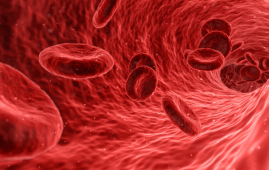

A novel artificial intelligence-based technology for detecting brain fluid flow around blood vessels could have significant implications for finding treatments for disorders like Alzheimer’s.
The perivascular gaps that surround cerebral blood arteries convey water-like fluids and aid in waste removal. Fluid flow changes have been associated to neurological disorders such as Alzheimer’s, small artery disease, strokes, and traumatic brain injuries, but they are difficult to assess in vivo.
University of Rochester Associate Professor Douglas Kelley led a diverse team of mechanical engineers, neuroscientists, and computer scientists in developing unique AI velocimetry techniques to properly determine brain fluid flow. The findings were published in the Proceedings of the National Academy of Sciences.
“In this study, we combined some measurements from inside the animal models with a novel AI technique that allowed us to effectively measure things that nobody’s ever been able to measure before,” says Kelley, a faculty member in Rochester’s Department of Mechanical Engineering.
The findings are the result of years of research undertaken by study co-author Maiken Nedergaard, codirector of Rochester’s Center for Translational Neuromedicine. Previously, the research was able to perform two-dimensional investigations on fluid flow in perivascular regions by infusing microscopic particles into the fluid and analyzing their position and velocity over time. However, more detailed measurements were required to fully comprehend the system’s complexities—and investigating such a crucial, fluid system is difficult.
To address this issue, the team teamed with Brown University’s George Karniadakis to use artificial intelligence. They used existing 2D data with physics-based neural networks to generate unprecedented high-resolution views of the system.
“This is a way to reveal pressures, forces, and the three-dimensional flow rate with much more accuracy than we can otherwise do,” says Kelley. “The pressure is important because nobody knows for sure quite what pumping mechanism drives all these flows around the brain yet. This is a new field.”
more recommended stories
 Fat-Regulating Enzyme Offers New Target for Obesity
Fat-Regulating Enzyme Offers New Target for ObesityKey Highlights (Quick Summary) Researchers identified.
 Spatial Computing Explains How Brain Organizes Cognition
Spatial Computing Explains How Brain Organizes CognitionKey Takeaways (Quick Summary) MIT researchers.
 Gestational Diabetes Risk Identified by Blood Metabolites
Gestational Diabetes Risk Identified by Blood MetabolitesKey Takeaways (Quick Summary for Clinicians).
 Phage Therapy Study Reveals RNA-Based Infection Control
Phage Therapy Study Reveals RNA-Based Infection ControlKey Takeaways (Quick Summary) Researchers uncovered.
 Pelvic Floor Disorders: Treatable Yet Often Ignored
Pelvic Floor Disorders: Treatable Yet Often IgnoredKey Takeaways (Quick Summary) Pelvic floor.
 Urine-Based microRNA Aging Clock Predicts Biological Age
Urine-Based microRNA Aging Clock Predicts Biological AgeKey Takeaways (Quick Summary) Researchers developed.
 Circadian Control of Neutrophils in Myocardial Infarction
Circadian Control of Neutrophils in Myocardial InfarctionKey Takeaways for HCPs Neutrophil activity.
 E-Cigarette Use and Heart Attack Risk in Former Smokers
E-Cigarette Use and Heart Attack Risk in Former SmokersKey Takeaways for Clinicians and Nurses.
 36-Week Pre-eclampsia Screening May Reduce Term Risk
36-Week Pre-eclampsia Screening May Reduce Term RiskA New Preventive Strategy for Term.
 Cardiovascular Risk and Sudden Cardiac Death in Diabetes
Cardiovascular Risk and Sudden Cardiac Death in DiabetesRising Sudden Cardiac Death (SCD) Risk.

Leave a Comment